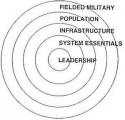MarcT-- always glad to do a little sophistical sparring.
Thanks for the clarifications of intent.
Of course I was smiling. I hoped you'd have seen the intended humor when I categorized Foucault both as a Structuralist and as a Post-structuralist. I think that most of what we say ought not to be placed in a specific box--to abstract in this manner is to falsify and misrepresent.I hope you're smiling when you say that. It was to avoid that attribution that I purposefully referenced Sapir.
This is where I want you to explain more about your concept of topologies, please.I would certainly agree with your caution here, and that is why I would prefer to conceive of it along the lines of intersecting and overlapping topologies rather than the more limited concept of "levels".
I suspect this applies equally to almost any other "school" seeking to standardize the domain of discourse that they view as unique to their area of investigation, sort of like establishing the equivalent of what cosmological physicists do with their grand unified theories (GUTs). Wittgenstein is particularly apropos here I think--we need to show the fly the way out of the fly bottle rather than cork it up inside.You could also point to the dismal failures of the Vienna School in their attempts to create a scientific language.
Thanks for catching my mistake re STNG and SW. It was well past my normal bed time. I was also looking at a miniature pod racer as I was typing that. Regarding Hegel, I tend to agree if you are speaking about the form of his presentation rather than the contents. (Maybe that just goes with writing/speaking in German.That's one of my favorite episodes ("Trek", not "Wars"). I also agree that biological commonalities form the basis for communications (NB that "communications" is different from "thought" - a crucial point that is often not addressed in the debates in this area). While I am not enamoured of Hegel, the dialectical approach is certainly one of the bases of understanding although I believe there are others.
Kant, Goethe, Heidegger, and even the Brothers Grimm are as opaque as Hegel IMHO.)





 Reply With Quote
Reply With Quote
 (LOLOLOL). Isn't there some famous quote about German being the only language where love poetry sounds like an argument?
(LOLOLOL). Isn't there some famous quote about German being the only language where love poetry sounds like an argument?


 )
)




Bookmarks